AUCTORES
Globalize your Research
Research Article | DOI: https://doi.org/10.31579/2641-0419/135Copyright
1National Heart Centre, The Royal Hospital, Muscat, Oman
2School of Nursing, The University of Adelaide, South Australia, Australia
3Medicine Department, The Royal Hospital, Muscat, Oman
4Medicine Department, Oman Medical Specialty Board, Muscat, Oman
5Medicine Department, Ministry of Health and Prevention (MOHAP), Dubai, UAE.
*Corresponding Author: Issa Al Salmi, The Royal Hospital, 23 July Street, P O Box 1331, code 111, Muscat, Oman and Oman Medical Specialty Board, Aziabah, Muscat, Oman,
Citation: Umaima Al-Raisi, Issa Al Salmi, Judy Magarey, Philippa Rasmussen, Suad Hannawi (2021) The Lived Experience of Nurses Working in Cardiology Services with Online Continuing Professional Programs in Advancing their Specialized Clinical Practice: Phenomenology Study Analysis. J. Clinical Cardiology and Cardiovascular Interventions, 4(9); Doi:10.31579/2641-0419/135
Copyright: © 2021 Issa Al Salmi, This is an open-access article distributed under the terms of the Creative Commons Attribution License, which permits unrestricted use, distribution, and reproduction in any medium, provided the original author and source are credited.
Received: 30 January 2021 | Accepted: 23 April 2021 | Published: 29 April 2021
Keywords: cardiology; nurses; education; on-line; continuing professional development (cpd); competency
Introduction: Cardiology nursing is one of the most challenging nursing specialties. Online continuing professional development (CPD) programs may allow nurses to fulfil the demand for specialty competency.
Methods and materials: This manuscript described the process of data analysis and discusses the philosophical and theoretical frameworks that shape this study. the study was conducted in one of the largest accredited teaching hospitals in South Australia.
Results: Volunteer participants were interviewed where each participant was given a pseudonym to protect confidentiality. First, interviews were transcribed manually. Transcription is considered an interpretive act and a perfect way to immerse oneself within the data because it helps create initial meanings. Second, the researcher listened to each interview while checking compatibility with the transcript. Third, the researcher read and re-read transcripts and highlighted essential ideas before the coding process. Repeated transcript reading helped develop main ideas, recognise shared thoughts, meanings, and patterns, and identify potential themes. Furthermore, it was evident during this stage that some of the researcher’s pre-assumptions regarding the phenomena were revealed in certain aspects of nurses’ lived experiences. In addition, audio recordings and a reflective diary were utilised to reveal non-verbal clues of participants, adding depth and transparency to data analysis. The final step involved writing a summary for each transcript containing the main ideas.
Conclusions: It is apparent that six main themes were embedded in the lived experiences of the RNs working in cardiac services and using the online CPD course to advance themselves knowledge and skills.
The health care is advancing on a daily basis and education of the health care staff is of paramount importance. Nurses are the corner of the health care system worldwide. Hence, preparation of a manual of professional ethics, development of a career structure for nurses, setting standards of nursing education; nursing practice, and issuing guidelines for registration and licensing would further enhance the population health perspectives [1-4].
Development and advancement of medical knowledge has a noticeable impact on the nursing profession [6]. Today, nurses are expected to possess knowledge and skills beyond basic nursing knowledge [6] Upholding the profession identity requires constant updating of nursing professional knowledge related skills [7,8. Continuing professional development is a core learning method for professional practice and a shared responsibility between the organisation and nurses [6].
Nurses working in a specialised clinical environment are challenged with dynamic changes in patient needs and rapid development of the care delivery system [10]. Cardiology is a very challenging specialty, and cardiology nurses need to possess high-level knowledge and skills to assist them in appropriate decision making. Silva and Ferreira [11] emphasise that the evolution of research and technology in the clinical specialist area requires new knowledge and skills for nurses to prepare them to respond effectively to special, complex needs.
Fundamental nursing knowledge and skills are insufficient to meet patients’ changeable and complex needs within specialised settings [12-15]. Silva and Ferreira [11] emphasised that specialised knowledge and experience work together to achieve effective interaction between the health professional and patients with specific needs. In other words, quality nursing care relies on specialised knowledge [16]. Therefore, nurses must be equipped with advanced specialised knowledge to understand disease progress and meet complex patient needs [5, 17-19].
There is a need to describe the process applied to analyse participant interview transcripts. Data analysis in a qualitative approach is a complex and unique process [20-22]. A phenomenological approach specifically attempts to unveil the meaning within the phenomena embedded in the lived experience to develop a deep understanding [23]. To achieve this, the researcher must become deeply immersed in the data and implement their own intuition, images and experiences in dissecting patterns and developing categories to reach a conclusion [24]. Also, the researcher must use a process that appropriately reflects the participant experience within transcribed interview text. Thematic data analysis was the most suitable approach for data analysis in this research, helping to unveil structured meanings of the individual’s experience.
Hence, this manuscript provides an informative description of the data analysis process. Thematic data analysis guided by Braun and Clark’s six step thematic data analysis model is explained. Each step is thoroughly described and six themes emerging from this study were revealed and defined.
This is described earlier in previous publication [25]. In summary: the study was conducted in one of the largest accredited teaching hospitals in South Australia. This hospital provides many cardiac services for patients from South Australia, the Northern Territory, and South East Asia who are referred from the AUS-health services. The cardiology department is divided into two main units: the cardiology unit which provides medical and interventional cardiac services and the cardiothoracic unit which provides surgical services. The department is staffed by a specialised multi-professional team, some of whom have completed specialised cardiac post-graduation diploma courses in order to meet the complex needs of cardiac patients. To keep the team abreast of the latest developments in practice, the in-service education department at local study setting runs several continuing professional development (CPD) programs for the cardiology department via varied learning modes, such as online CPD programs, classroom learning and bedside-based learning. The nursing team maintains advanced clinical skills through online CPD, orientation programs, and in-service classroom-based courses. Regarding online CPD courses, electrocardiography interpretation and underwater sealing draining management courses are mandatory courses which all registered nurses must complete while working in medical or surgical cardiac wards [25, 26].
Initially, this study explains the development of hermeneutic phenomenology. Then, it presents significance of the application of hermeneutic phenomenological research in the nursing profession. Finally, it provides a detailed discussion of van Manen’s methodological research structure that guided exploration of the lived experience. It describes the process of data collection. Starting with a detailed description for the study setting, then sampling and recruitment procedures are stated. Also, it explains the phenomenological interview process conducted by the researcher to explore the registered nurse experience as gathered through a systematic process.
Participant profile
Five volunteer participants were interviewed for this study. Each participant was given a pseudonym to protect confidentiality. A brief description of each participant is given below.
Ann is a 23-year-old junior registered nurse, who has been working on a cardiology ward for one and a half years. Ann enrolled in the online ECG interpretation course and successfully completed four of the twelve modules. She found the course well structured, easy to access and progress through, and relevant to actual practice. On the other hand, she found that the course lacked critical thinking components as it only focused on essential assessment and management. Also, she pointed out that it is hard to understand all parts of the ECG rhythms online, as she experienced ECG in real practice as more complex than the scenarios shown in the course, and consequently, she needed to seek clarification on some points to resolve her queries and help her to interpret ECG rhythms. She did most of the course in her own time at home and dedicating time to completing the course. It was a priority for her.
good now that we still we have that information that we can still go back over because it was a lot of information in that short period of time but it was good to go back over it .
Can be revised
I can go back over the quizzes or go back over the text information and the slide show that they showed and all that information and goes from there, and also when looking at ECG in the ward.
Can be revised
It is flexible course
Brenda is a 59-year-old registered nurse who has been working on cardiology wards for five years. She was enrolled in two online mandatory courses: the ECG interpretation course and the underwater sealing drain (UWSD) management course. She found these courses enlightening, educational, and relevant to actual practice. She expressed the view that the courses helped her to bridge the gap in her competencies as the courses were comprehensive. The online courses provided her with flexibility in terms of seeking particular knowledge she needed; however, the busy nature of ward work did not permit her to acquire such knowledge on the ward. Therefore, she dedicated time to study at home which was not pleasant for her. She had to use multiple resources, such as mentors and online resources, to aid her understanding of topics for which she needed further clarification. She supports the idea of having classroom time or bedside clinical instruction sessions on a regular basis to help shape knowledge gained from online CPD courses. Finally, she was satisfied with the knowledge she gained, describing it as advanced, and she was able to utilise it to provide patient education and junior nurse mentorship more effectively.
that you can access it during working hours also at home, I think it is handy to have it up there
Accessibility
having it there on line resources to go back and look at and reflect on I find it really handy
Can be revised
if we had time to actually sit down and do the education in the ward and that’s where we struggle here. We don’t have a lot of time to do that. We are lucky to get to lunch!
Accessibility
Generally increase your knowledge then and there because you can look it up and the information is there.
Can be revised
Lucy is a 24-year-old registered nurse who has been working on a cardiology ward for one and a half years. She joined cardiology services because of her interest in becoming a cardiology nurse. She successfully completed the online ECG interpretation course, which she described as good, accessible and flexible. She found its best feature and greatest advantage as being available online, even after completing it. Now the information is still available when she wants to reflect on actual practice she has experienced. On the other hand, the course’s disadvantage was that there is a lot of information that must be taught in a short period. She supports the concept of having classroom sessions embedded within the course as that allows the learner to revise what has been learned online, question, and seek further explanation. She stated that she had to dedicate time to do the course at home. She was unable to benefit from accessing the course at work as the ward is always too busy. She stated that her cardiac clinical practice is gradually advancing with the assistance of the course content continuing to be accessible.
good in a way like you can rewind.
I can rewind, re do it and re listen to it.
Can be revised
Yes you can re watch it and reflect back and they got something like print out, like a work book, but it’s not really a work book but it like a work sheet
Can be revised
Mary is a 30-year-old registered nurse, who has been working on cardiology wards for six years. She did the online ECG interpretation course, although she was unsure how she would cope with an online course. She reported that the purely online nature of the course did not meet her learning needs which she attributed to her own method of learning. It was difficult for her to learn from a computer and totally absorb all that she read on that from the computer screen. She stressed that she is a person-to-person learner and her learning is achieved through discussion. Therefore, she recommends having a clinical instructor attached to the course to answer questions from students seeking clarification of online components, and to discuss case studies and examples of ECGs brought by the staff from their clinical settings. On the other hand, she considered the advantages of having an online ECG interpretation course as being convenient, accessible and flexible. She regarded the most beneficial factor of the course was that after she had completed it, she has been able to go back to the online modules to revise and reflect on her practice. Overall, she stated that the course had enabled her to extend her knowledge and increase her skill level.
I don’t do on line education here because there is no time. So I do it in my own time at home
Accessibility
you do it and rehash what you have learned from before.
Annoys a lot of us because, as you said , it takes time out of your own family and your own family setting, but the fact is here, it is a very busy ward, as you have worked here, you just don’t have time to do, and if you do you cannot focus, because the bell is ringing, someone is asking.
Accessibility
I’ll need to do it at night, on my night off, until the midnight and I’ll do the online competencies.
flexibility
Theme two: Commitment
Susan is a registered nurse who preferred not to disclose her age. She has been working in cardiology services for more than one year. However, she has been a nurse for nine years. Susan did the online ECG interpretation course, describing her experience as good in that she was able to revise, redo, and relisten to the course when she needed clarification of certain points, although she admitted that the online course was somewhat vague. She found that the course was, for her, like just staring at a picture without being able to work out the relation between the ECG and descriptions of it. She suggested refining the online learning material by adding a highlighting element to emphasise the most important aspects of ECG description. She stated that the flexibility and accessibility of the course helped and promoted her overall understanding. However, she stated she was not certain that the course shapes her knowledge and competencies to an advanced level. At the same time, she was annoyed because she had to dedicate her own time to do the course. She stressed that the learning process is an individual matter; different people acquire and retain their learning in different ways.
But most of it, I have to do it at home
Accessibility
With data in phenomenological research being voluminous and rich, it is essential for the researcher to be immersed in the data to gain a deep understanding of the topic of interest. To gain hermeneutic understanding, the researcher’s pre-understanding and conversational data play a vital role [27]. The researcher must be aware of his/her own pre-understanding, starting with recognising their own fusion of horizons before understanding the phenomena in a new perspective beyond their horizons [23, 28]. The researcher in this study had a pre-understanding of the nature of skills required in a cardiac setting and methods to achieve competency. It was argued by Gadamer [29] that understanding can be achieved through dialogue between the researcher, participants and the text. Furthermore, he stated that conversation allows the researcher to be immersed in the data. In fact, ‘human science’ meanings in an individual’s experience are multidimensional [23]. Indicating that understanding is sought through analysis of conversation, either interview or text, to uncover meanings of the individual’s lived experience. Consequently, as seeking understanding through interpretation is the aim of the phenomenological hermeneutic approach, the researcher needs to adopt a systematic method to analyse participant dialogue and text.
The Gadamerian hermeneutic cycle offered a framework that emphasised how researchers must consider the whole, with part of the text providing unity of meanings within [30]. van Manen [23] used the notion of phenomenological reflection to refer the researcher in search of meaning within the text. He argued that meanings of the lived experience gained from participants within the text are structural in meanings and themes. Furthermore, he emphasised that gaining insight into the essence of the phenomena requires clarifying and interpretation of structures of the meanings found in the lived experience. Thus, this research adopted an analytical framework for analysis, using participant interviews to achieve the purpose of the Gadamerian hermeneutic cycle and van Manens’ perspectives of life experience research.
van Manen [23] defined thematic analysis as ‘the process of recovering the theme or themes that are embodied and dramatized in the evolving meanings imagery of the work’. In this research, thematic analysis was applied as it was the most suitable approach to reveal the essence of the phenomena within experiences of registered nurses using online CPD to advance their skills. van Manen [23] stressed that human science meanings can only be communicated through textual and structural meanings, as well as thematic forms. It is argued that the notion of theme usually refers to mathematical application of the frequency of selected terms in the transcript [23]. At the same time, van Manen [23] found that themes in participant transcripts inform an experiential structure revealing the lived experience. Thus, for phenomenological hermeneutic research thematic analysis provides an insightful approach to discover and disclose meaning structures in the lived experience [23]. For this research, interview transcripts were analysed using Braun and Clarke [31] six step thematic analysis approach to discover repeated patterns that reflect the meanings of lived experiences.
Braun and Clarke [31] introduced a six-step thematic analysis model for qualitative research (Figure.1). This model provides the researcher with an outline for analysis by constantly moving back and forth across rich and detailed data. This process enhances understanding through interpretation according to the Gadamerian hermeneutic circle, which involves moving from the whole to part, and part to the whole of the data [30]. The six steps of the thematic analysis model are described in this section.
In Phase One (Familiarising with the data), it was imperative that the researcher was familiar with the depth and richness of collected data. Braun and Clarke [31] stated that immersion in collected data is vital during this stage to construct initial analytical thoughts. Also, van Manen’s methodological structure recommended being very close to the lived experience in order to grasp participant verbal and non-verbal clues as way of exploring the most of their lived experiences [30]. The researcher used the following strategies to become familiar with the data. First, interviews were transcribed manually. Transcription is considered an interpretive act and a perfect way to immerse oneself within the data because it helps create initial meanings [31]. Second, the researcher listened to each interview while checking compatibility with the transcript. Third, the researcher read and re-read transcripts and highlighted essential ideas before the coding process (Table 1).
Repeated transcript reading helped develop main ideas, recognise shared thoughts, meanings and patterns, and identify potential themes [31]. Furthermore, it was evident during this stage that some of the researcher’s pre-assumptions regarding the phenomena were revealed in certain aspects of nurses’ lived experiences. In addition, audio recordings and a reflective diary were utilised to reveal non-verbal clues of participants, adding depth and transparency to data analysis. The final step involved writing a summary for each transcript containing the main ideas (appendix 1).
pendix 1: Sample interview summary
Lucy Interview Summary
Lucy is a registered nurse who is working in a cardiology ward for one and a half years. Lucy joined that cardiology service because of her interest in becoming a cardiology nurse. She normally updates her knowledge using both text books and online resources. However, she mostly uses online resources because they contain more recent and updated information.
Regarding her experience of using the online ECG interpretation course, she stated that the online learning was good for the following reasons: first, the new course was short compared with the older version with the old version. Second, the information is accessible even after she has finished the course. She further explained that the flexibility and the accessibility of the online course allowed her to go back to the content and revise whenever she came across a new type of rhythm on the ward. It made reflective learning easy and accessible for her. Also, she could repeat the quizzes that are within the course as a way to refresh her information.
On the other hand, she found the disadvantage of doing the short course was that a lot of information has to be taught in a short period. However, she expressed her gladness for being able to attend the weekly session (which was optional due to the limited seats). She found that helped to keep her up-to-date with her learning. After each session, as she stated, she revised what was discussed in the classroom and set up the question that she wanted further explanation for. She emphasised that she liked the course with the classroom session embedded within it for the previously mentioned reasons. At the same time, she assumed that this is her personal preference in learning and other nurses may prefer to accomplish it just through the online components.
Lucy was doing the online component at home only because of the busy ward and lack of time for any type of self-learning. However, doing it at home in her own time was not an issue for her as she had to dedicate time to do it as she stated. She emphasised that her social life was not affected, and she managed her time very well. She also mentioned that she has very good computer skills and the course was easy to access and go through.
As she completed the course a few weeks before the interview, she found herself not yet ready to transfer this information to the student and newly graduated nurses. Instead, she stated that she is at that stage where she is going back to the course content and relating it to practice and discussing it with the senior nurses. She stated that she will be happy to help others interpret the ECG after she has become competent.
She concluded the interview by stating that she enjoyed doing the course as it was not as stressful as was described by her colleagues who did the classroom based course. She said that the course has advanced her knowledge indeed, and, as long as the course content is accessible, her knowledge and skills will be improved as she will always have the chance to relate it to her practice and the cases on the ward.
The researcher used the following steps to conduct the coding process:
The researcher conducted ongoing reflection on the participant experience through the transcripts. Further refinement and clustering of codes and subthemes as appropriate, resulting in further subthemes and themes emerging. This step is comprehensively explained in next section. At the end of this phase, the researcher identified a long list of initial codes detected in the data set (Table 2).
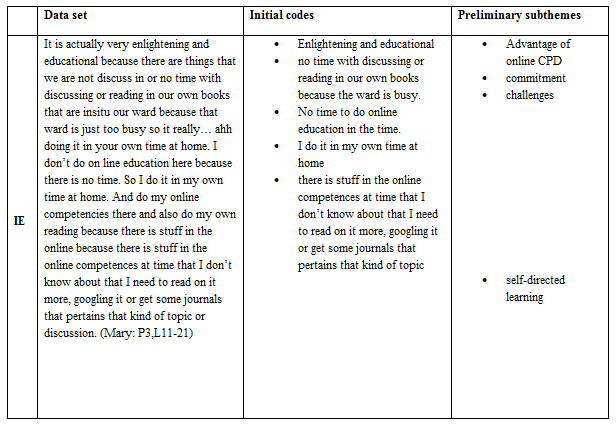
Table 2: Example of the identification of the initial codes from data set of Marys’ interview transcript. Note: (IR: interviewer, IE: interviewee, P3: participant number, L: line number)
In phase three (search for themes), we focused on analysing data within a broader context by investigating emerging themes from the subthemes that emerged from initial codes as extracted from participant experience descriptions [31]. It is worth mentioning at this point that the act of merging the basic patterns to identify a common theme is a hermeneutic process. In other words, the researcher sought to capture coherence from the participants’ described experiences and achieve a fusion of horizons [32].
The Gadamerian philosophical concept of the fusion of horizons influenced the researcher when searching for themes from initial codes. During this stage, firstly, the researcher identified sub-themes with similar meanings or were interrelated under one broad theme. For example, the subthemes ‘self-directed learning’ and ‘advantage of online CPD’ built an initial theme called ‘knowledge advancement’. This approach facilitated clearer understanding of the meanings of lived experiences. In a phenomenological hermeneutic approach, it is essential that the reader clarifies the cognitive movement during data analysis(23). The researcher utilised the same table that was initially created in phase two, categorising the codes by theme (Table 2). Second, each theme, including the sub-theme, codes, and relevant data extracts, was transferred to a new Microsoft Word file as a preparatory step for the next phase (appendix 2).
Appendix 2: Development graph of the six themes
Theme one: convenience
Participants | Extracted data (response) | Open code | Sub themes |
Brenda | that you can access it during working hours also at home, I think it is handy to have it up there |
| Accessibility |
having it there on line resources to go back and look at and reflect on I find it really handy |
| Can be revised | |
if we had time to actually sit down and do the education in the ward and that’s where we struggle here. We don’t have a lot of time to do that. We are lucky to get to lunch! |
| Accessibility | |
Generally increase your knowledge then and there because you can look it up and the information is there. |
| Can be revised | |
Lucy | good in a way like you can rewind. I can rewind, re do it and re listen to it. |
| Can be revised |
Yes you can re watch it and reflect back and they got something like print out, like a work book, but it’s not really a work book but it like a work sheet |
| Can be revised | |
Susan | But most of it, I have to do it at home |
| Accessibility |
Ann | good now that we still we have that information that we can still go back over because it was a lot of information in that short period of time but it was good to go back over it .
|
| Can be revised |
I can go back over the quizzes or go back over the text information and the slide show that they showed and all that information and goes from there, and also when looking at ECG in the ward. |
| Can be revised | |
It is flexible course |
| flexibility | |
Mary | I don’t do on line education here because there is no time. So I do it in my own time at home |
| Accessibility |
you do it and rehash what you have learned from before. |
|
| |
Annoys a lot of us because, as you said , it takes time out of your own family and your own family setting, but the fact is here, it is a very busy ward, as you have worked here, you just don’t have time to do, and if you do you cannot focus, because the bell is ringing, someone is asking. |
| Accessibility | |
I’ll need to do it at night, on my night off, until the midnight and I’ll do the online competencies. |
| flexibility |
Theme two: Commitment

Theme three: Mentorship
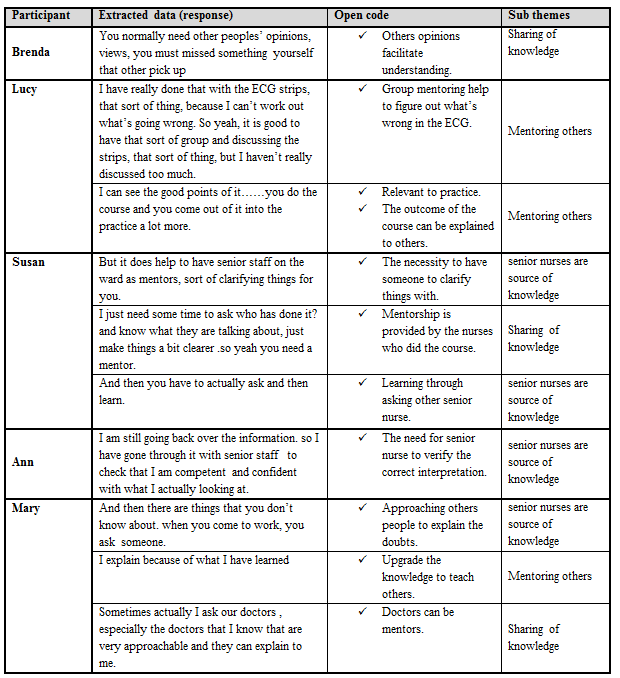
Themes four: Individual learning style
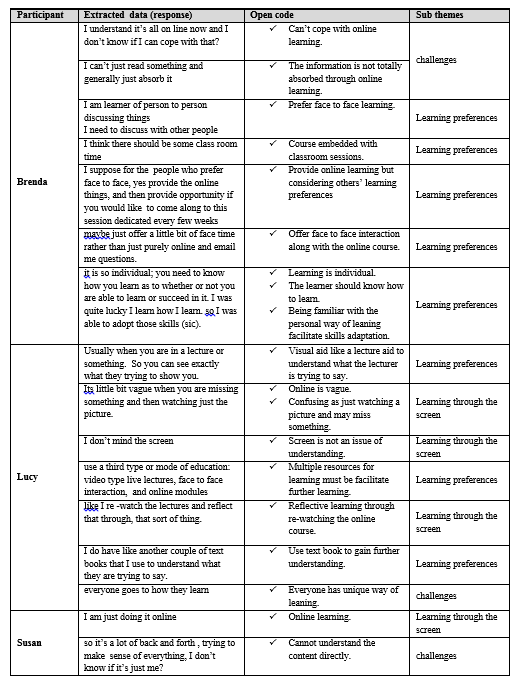
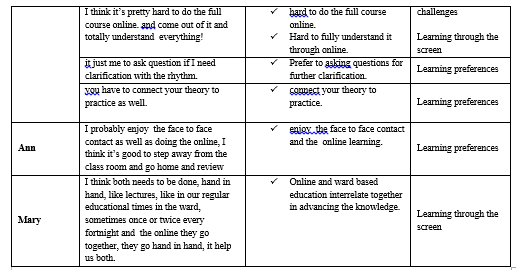
Theme five: Application to Practice
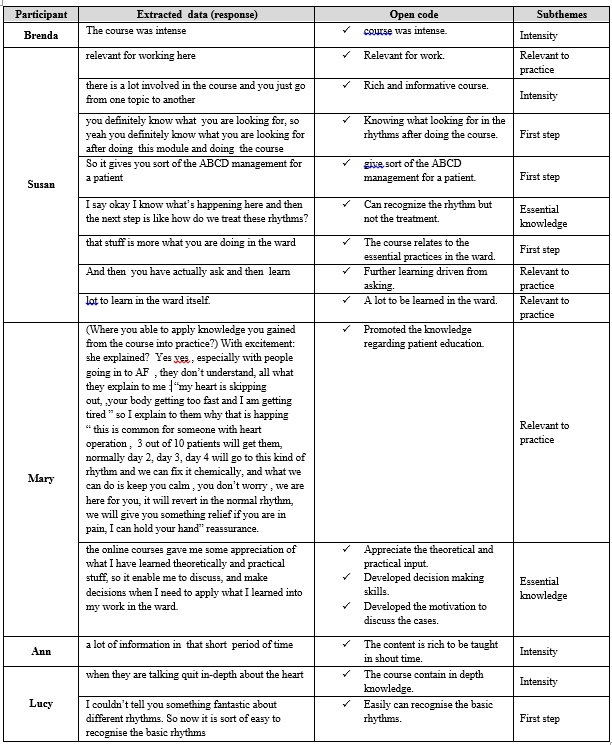
Theme six: Satisfaction with the online course
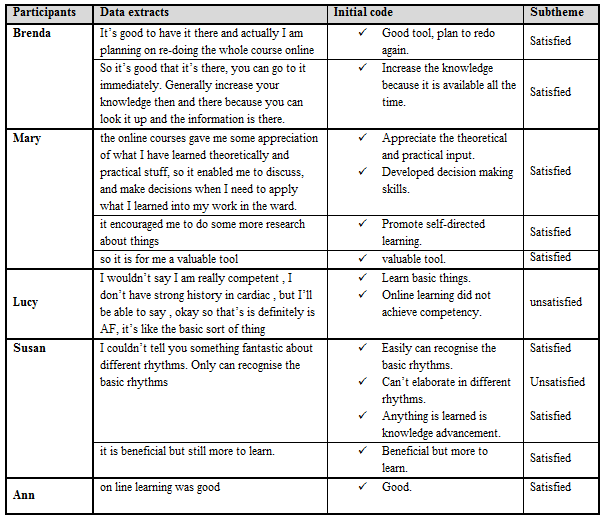
In phase four (review of themes), we aim to achieve meaningful coherence within the data of each theme and to clearly distinguish between different themes [31]. As in the previous phase, the researcher separated each theme from its sub-themes, codes, and related data extracts to facilitate the reviewing process, which was done by applying two steps. It was necessary to acknowledge that the data set represents part of transcribed interviews, whereas the data extract is the significant part of the data. In the first step, the researcher read and re-read codes, sub-themes and main themes against data extracts to ensure that all presented data was coherent and related. As a result, some of the initial themes were refined or collapsed, and other new themes emerged. Once all themes were revised by applying this step, the researcher created a hierarchical diagram for each theme which is described in the next phase.
In accordance with Braun and Clarke [31], step two was applied once the researcher was satisfied with the concordance between themes, their codes and data extracts. Through this step, the researcher ensured that developed themes reflected description of the whole data set, in addition to determining emergence of new codes. Thus, achieving validity and accurate results in meanings embodied in participants’ lived experience descriptions [31]. In other words, this step enhanced applicability of data which helped achieve study rigour Therefore, re-reading was a main task in this step. Considered as a hermeneutic circle task, it allowed the researcher to move back and forth within the text to achieve the interpretive purpose by ensuring that all the data fit together and represented the meanings of participants’ experiences (Figure 1).
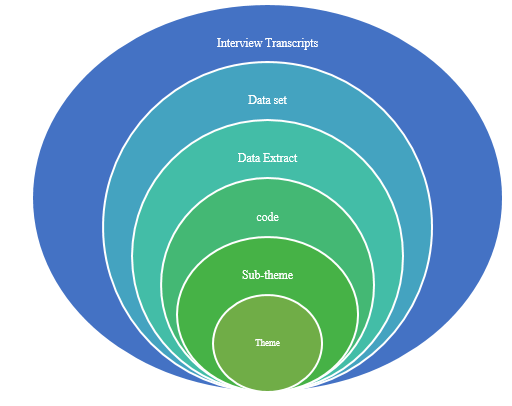
Figure 1: Application of the hermeneutic cycle adopted from (Austgard 2012)
In phase five (defining the themes), we aim to identify the essence of the phenomena in participants’ lived experiences by refining and defining identified themes [31]. Here, the researcher was required to present each theme with a detailed analysis to articulate how all data sets fitted together under one theme. In other words, the researcher wrote a story that explained the relationship between themes, relevant data, and the phenomenological inquiry [31].
Transcript codification resulted in a set of shared meaning codes, labelled as subthemes. The researcher managed to identify unity and commonalities in meaning from subthemes under six majors’ themes. The major themes were convenience, commitment, mentorship, individual learning styles, application to practice, and satisfaction with the online course.
In theme one (convenience), the development of this theme was determined from comments made by the registered nurses (RNs) regarding features of the online courses. As evidenced by coding transcripts from participant interviews, the RNs experienced the online CPD course with features that did not restrict usage to a time or a place. The features that categorised as subthemes were: can be revised, accessibility and flexibility (Figure 2).

Figure 2: Thematic map of convenience
The second major theme (commitment), which represented the experience of RNs, was being responsible for their own learning. These RNs were committed to pass the course. It was evident through the codification process that self-directed learning, balance between personal life and professional growth, and obligation exemplified these RNs experience of being committed to the course (Figure 3).
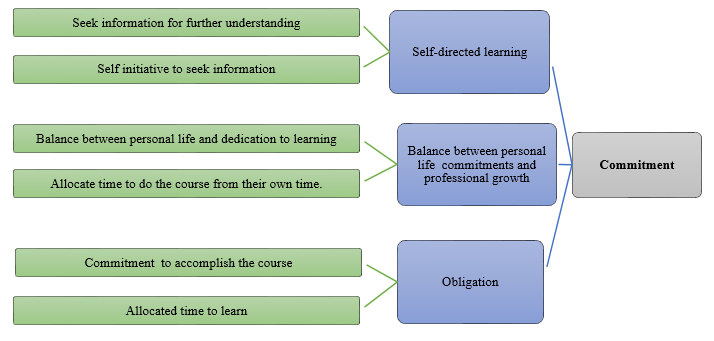
Figure 3: Thematic map of commitment
The third major theme (mentorship) presented analysis of the experience of the RNs in using the online course as a means for two-way mentorship. The RNs attributed their experience to the explanation and clarification of course content. The coding process evidenced that RNs valued three major aspects of their experience that related to mentorship: knowledge sharing, mentoring others and senior nurses as sources of knowledge (Figure 4).
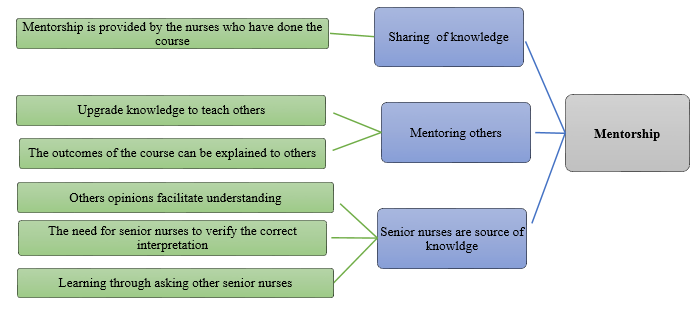
Figure 4: Thematic map of mentorship
The fourth major theme (individual learning style) presented aspects of the study related to learning styles of RNs. The development of this theme emerged from comments made by RNs about their own learning styles and coping strategies when using the online course. The codification process revealed three subthemes: learning preferences, screen-based learning, and challenges (Figure 5).

Figure 5: thematic map of individual learning style
The fifth major theme (application to practice) arose from comments made by RNs regarding the relationship between knowledge and skills related to clinical practice and online CPD courses. The coding process categorised the experience of RNs into four major areas: intensity, relevant to practice, essential knowledge, and first step (Figure 6).

Figure 6: Thematic map of application to practice
The final theme (satisfaction with online CPD course) was identified from comments made by RNs regarding their satisfaction with the course. Coding their interview transcripts revealed two major subthemes: satisfied and unsatisfied (Figure 7).

Figure 7: Thematic map of satisfaction with online CPD course
Phase six is the reporting phase.
This phase included final analysis and a written report for each theme. The report should provide logical and cohesive presentation of evidence from participant data extracts that support their prevalence to the theme development. This phase is represented in the interpretative chapter, rather than as a report.
There were six main themes embedded in the lived experiences of the RNs working in cardiac services and using the online CPD course to advance themselves knowledge and skills. The thematic data analysis served the purpose of the phenomenological hermeneutic study by revealing and understanding the essence of the RNs. The Gadamerian hermeneutic concept and van Manen’s research methodological perspective were integrated for the process of data analysis, allowing the researcher to better understand the phenomena under investigation.
Declarations Section:
Disclosure of potential conflicts of interest:
The study was approved by the Research Ethics Committee at the Royal Adelaide Hospital (approval number HREC/16/RAH/168). The study groups certify that the study was performed in accordance with the ethical standards as laid down in the 1964 Declaration of Helsinki and its later amendments ethical standards. The research was conducted according to the NHMRC National Statement on Ethical Conduct in Human Research, 2007.
Consent for publication: All authors have agreed to the publication and to be accountable for all aspects of the work in ensuring that questions related to the accuracy or integrity of any part of the work are appropriately investigated and resolved.
Availability of data and material: Data is part of the thesis study and not available publicly.
Competing interests: Both authors declare no conflict of Interest related to the current manuscript.
Funding: no funding available for both authors.
Author Contribution Statement: All authors have contributed equally.
We would like to thank the participant for sharing their experience.
Clearly Auctoresonline and particularly Psychology and Mental Health Care Journal is dedicated to improving health care services for individuals and populations. The editorial boards' ability to efficiently recognize and share the global importance of health literacy with a variety of stakeholders. Auctoresonline publishing platform can be used to facilitate of optimal client-based services and should be added to health care professionals' repertoire of evidence-based health care resources.

Journal of Clinical Cardiology and Cardiovascular Intervention The submission and review process was adequate. However I think that the publication total value should have been enlightened in early fases. Thank you for all.

Journal of Women Health Care and Issues By the present mail, I want to say thank to you and tour colleagues for facilitating my published article. Specially thank you for the peer review process, support from the editorial office. I appreciate positively the quality of your journal.
Journal of Clinical Research and Reports I would be very delighted to submit my testimonial regarding the reviewer board and the editorial office. The reviewer board were accurate and helpful regarding any modifications for my manuscript. And the editorial office were very helpful and supportive in contacting and monitoring with any update and offering help. It was my pleasure to contribute with your promising Journal and I am looking forward for more collaboration.

We would like to thank the Journal of Thoracic Disease and Cardiothoracic Surgery because of the services they provided us for our articles. The peer-review process was done in a very excellent time manner, and the opinions of the reviewers helped us to improve our manuscript further. The editorial office had an outstanding correspondence with us and guided us in many ways. During a hard time of the pandemic that is affecting every one of us tremendously, the editorial office helped us make everything easier for publishing scientific work. Hope for a more scientific relationship with your Journal.

The peer-review process which consisted high quality queries on the paper. I did answer six reviewers’ questions and comments before the paper was accepted. The support from the editorial office is excellent.

Journal of Neuroscience and Neurological Surgery. I had the experience of publishing a research article recently. The whole process was simple from submission to publication. The reviewers made specific and valuable recommendations and corrections that improved the quality of my publication. I strongly recommend this Journal.

Dr. Katarzyna Byczkowska My testimonial covering: "The peer review process is quick and effective. The support from the editorial office is very professional and friendly. Quality of the Clinical Cardiology and Cardiovascular Interventions is scientific and publishes ground-breaking research on cardiology that is useful for other professionals in the field.

Thank you most sincerely, with regard to the support you have given in relation to the reviewing process and the processing of my article entitled "Large Cell Neuroendocrine Carcinoma of The Prostate Gland: A Review and Update" for publication in your esteemed Journal, Journal of Cancer Research and Cellular Therapeutics". The editorial team has been very supportive.

Testimony of Journal of Clinical Otorhinolaryngology: work with your Reviews has been a educational and constructive experience. The editorial office were very helpful and supportive. It was a pleasure to contribute to your Journal.

Dr. Bernard Terkimbi Utoo, I am happy to publish my scientific work in Journal of Women Health Care and Issues (JWHCI). The manuscript submission was seamless and peer review process was top notch. I was amazed that 4 reviewers worked on the manuscript which made it a highly technical, standard and excellent quality paper. I appreciate the format and consideration for the APC as well as the speed of publication. It is my pleasure to continue with this scientific relationship with the esteem JWHCI.

This is an acknowledgment for peer reviewers, editorial board of Journal of Clinical Research and Reports. They show a lot of consideration for us as publishers for our research article “Evaluation of the different factors associated with side effects of COVID-19 vaccination on medical students, Mutah university, Al-Karak, Jordan”, in a very professional and easy way. This journal is one of outstanding medical journal.
Dear Hao Jiang, to Journal of Nutrition and Food Processing We greatly appreciate the efficient, professional and rapid processing of our paper by your team. If there is anything else we should do, please do not hesitate to let us know. On behalf of my co-authors, we would like to express our great appreciation to editor and reviewers.

As an author who has recently published in the journal "Brain and Neurological Disorders". I am delighted to provide a testimonial on the peer review process, editorial office support, and the overall quality of the journal. The peer review process at Brain and Neurological Disorders is rigorous and meticulous, ensuring that only high-quality, evidence-based research is published. The reviewers are experts in their fields, and their comments and suggestions were constructive and helped improve the quality of my manuscript. The review process was timely and efficient, with clear communication from the editorial office at each stage. The support from the editorial office was exceptional throughout the entire process. The editorial staff was responsive, professional, and always willing to help. They provided valuable guidance on formatting, structure, and ethical considerations, making the submission process seamless. Moreover, they kept me informed about the status of my manuscript and provided timely updates, which made the process less stressful. The journal Brain and Neurological Disorders is of the highest quality, with a strong focus on publishing cutting-edge research in the field of neurology. The articles published in this journal are well-researched, rigorously peer-reviewed, and written by experts in the field. The journal maintains high standards, ensuring that readers are provided with the most up-to-date and reliable information on brain and neurological disorders. In conclusion, I had a wonderful experience publishing in Brain and Neurological Disorders. The peer review process was thorough, the editorial office provided exceptional support, and the journal's quality is second to none. I would highly recommend this journal to any researcher working in the field of neurology and brain disorders.

Dear Agrippa Hilda, Journal of Neuroscience and Neurological Surgery, Editorial Coordinator, I trust this message finds you well. I want to extend my appreciation for considering my article for publication in your esteemed journal. I am pleased to provide a testimonial regarding the peer review process and the support received from your editorial office. The peer review process for my paper was carried out in a highly professional and thorough manner. The feedback and comments provided by the authors were constructive and very useful in improving the quality of the manuscript. This rigorous assessment process undoubtedly contributes to the high standards maintained by your journal.

International Journal of Clinical Case Reports and Reviews. I strongly recommend to consider submitting your work to this high-quality journal. The support and availability of the Editorial staff is outstanding and the review process was both efficient and rigorous.

Thank you very much for publishing my Research Article titled “Comparing Treatment Outcome Of Allergic Rhinitis Patients After Using Fluticasone Nasal Spray And Nasal Douching" in the Journal of Clinical Otorhinolaryngology. As Medical Professionals we are immensely benefited from study of various informative Articles and Papers published in this high quality Journal. I look forward to enriching my knowledge by regular study of the Journal and contribute my future work in the field of ENT through the Journal for use by the medical fraternity. The support from the Editorial office was excellent and very prompt. I also welcome the comments received from the readers of my Research Article.

Dear Erica Kelsey, Editorial Coordinator of Cancer Research and Cellular Therapeutics Our team is very satisfied with the processing of our paper by your journal. That was fast, efficient, rigorous, but without unnecessary complications. We appreciated the very short time between the submission of the paper and its publication on line on your site.

I am very glad to say that the peer review process is very successful and fast and support from the Editorial Office. Therefore, I would like to continue our scientific relationship for a long time. And I especially thank you for your kindly attention towards my article. Have a good day!

"We recently published an article entitled “Influence of beta-Cyclodextrins upon the Degradation of Carbofuran Derivatives under Alkaline Conditions" in the Journal of “Pesticides and Biofertilizers” to show that the cyclodextrins protect the carbamates increasing their half-life time in the presence of basic conditions This will be very helpful to understand carbofuran behaviour in the analytical, agro-environmental and food areas. We greatly appreciated the interaction with the editor and the editorial team; we were particularly well accompanied during the course of the revision process, since all various steps towards publication were short and without delay".

I would like to express my gratitude towards you process of article review and submission. I found this to be very fair and expedient. Your follow up has been excellent. I have many publications in national and international journal and your process has been one of the best so far. Keep up the great work.

We are grateful for this opportunity to provide a glowing recommendation to the Journal of Psychiatry and Psychotherapy. We found that the editorial team were very supportive, helpful, kept us abreast of timelines and over all very professional in nature. The peer review process was rigorous, efficient and constructive that really enhanced our article submission. The experience with this journal remains one of our best ever and we look forward to providing future submissions in the near future.
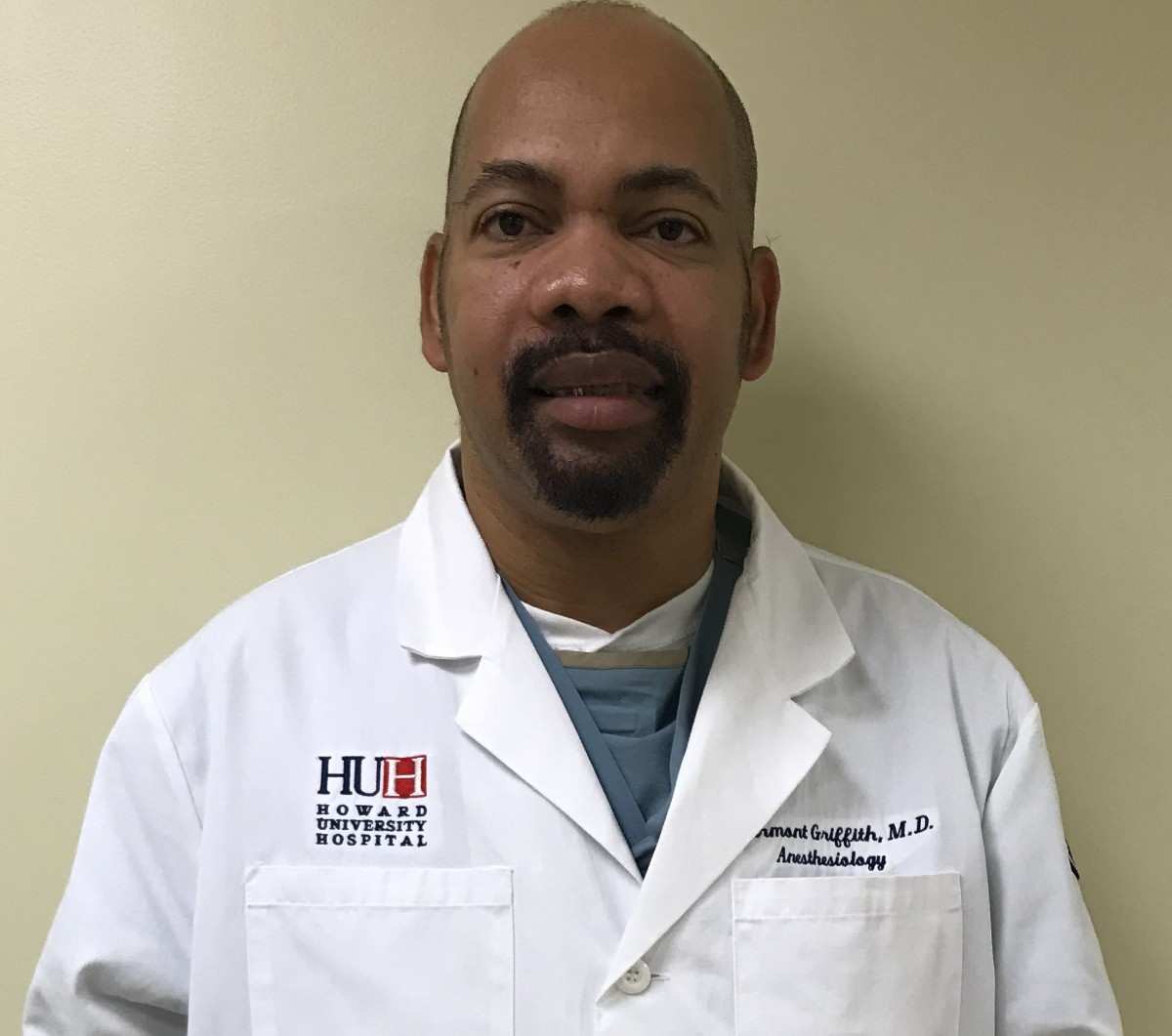
I am very pleased to serve as EBM of the journal, I hope many years of my experience in stem cells can help the journal from one way or another. As we know, stem cells hold great potential for regenerative medicine, which are mostly used to promote the repair response of diseased, dysfunctional or injured tissue using stem cells or their derivatives. I think Stem Cell Research and Therapeutics International is a great platform to publish and share the understanding towards the biology and translational or clinical application of stem cells.

I would like to give my testimony in the support I have got by the peer review process and to support the editorial office where they were of asset to support young author like me to be encouraged to publish their work in your respected journal and globalize and share knowledge across the globe. I really give my great gratitude to your journal and the peer review including the editorial office.

I am delighted to publish our manuscript entitled "A Perspective on Cocaine Induced Stroke - Its Mechanisms and Management" in the Journal of Neuroscience and Neurological Surgery. The peer review process, support from the editorial office, and quality of the journal are excellent. The manuscripts published are of high quality and of excellent scientific value. I recommend this journal very much to colleagues.

Dr.Tania Muñoz, My experience as researcher and author of a review article in The Journal Clinical Cardiology and Interventions has been very enriching and stimulating. The editorial team is excellent, performs its work with absolute responsibility and delivery. They are proactive, dynamic and receptive to all proposals. Supporting at all times the vast universe of authors who choose them as an option for publication. The team of review specialists, members of the editorial board, are brilliant professionals, with remarkable performance in medical research and scientific methodology. Together they form a frontline team that consolidates the JCCI as a magnificent option for the publication and review of high-level medical articles and broad collective interest. I am honored to be able to share my review article and open to receive all your comments.

“The peer review process of JPMHC is quick and effective. Authors are benefited by good and professional reviewers with huge experience in the field of psychology and mental health. The support from the editorial office is very professional. People to contact to are friendly and happy to help and assist any query authors might have. Quality of the Journal is scientific and publishes ground-breaking research on mental health that is useful for other professionals in the field”.
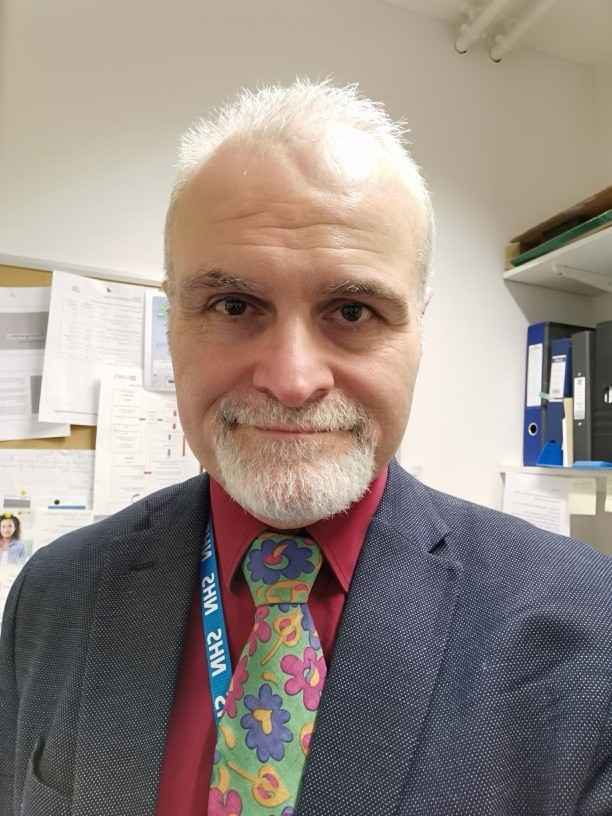
Dear editorial department: On behalf of our team, I hereby certify the reliability and superiority of the International Journal of Clinical Case Reports and Reviews in the peer review process, editorial support, and journal quality. Firstly, the peer review process of the International Journal of Clinical Case Reports and Reviews is rigorous, fair, transparent, fast, and of high quality. The editorial department invites experts from relevant fields as anonymous reviewers to review all submitted manuscripts. These experts have rich academic backgrounds and experience, and can accurately evaluate the academic quality, originality, and suitability of manuscripts. The editorial department is committed to ensuring the rigor of the peer review process, while also making every effort to ensure a fast review cycle to meet the needs of authors and the academic community. Secondly, the editorial team of the International Journal of Clinical Case Reports and Reviews is composed of a group of senior scholars and professionals with rich experience and professional knowledge in related fields. The editorial department is committed to assisting authors in improving their manuscripts, ensuring their academic accuracy, clarity, and completeness. Editors actively collaborate with authors, providing useful suggestions and feedback to promote the improvement and development of the manuscript. We believe that the support of the editorial department is one of the key factors in ensuring the quality of the journal. Finally, the International Journal of Clinical Case Reports and Reviews is renowned for its high- quality articles and strict academic standards. The editorial department is committed to publishing innovative and academically valuable research results to promote the development and progress of related fields. The International Journal of Clinical Case Reports and Reviews is reasonably priced and ensures excellent service and quality ratio, allowing authors to obtain high-level academic publishing opportunities in an affordable manner. I hereby solemnly declare that the International Journal of Clinical Case Reports and Reviews has a high level of credibility and superiority in terms of peer review process, editorial support, reasonable fees, and journal quality. Sincerely, Rui Tao.

Clinical Cardiology and Cardiovascular Interventions I testity the covering of the peer review process, support from the editorial office, and quality of the journal.

Clinical Cardiology and Cardiovascular Interventions, we deeply appreciate the interest shown in our work and its publication. It has been a true pleasure to collaborate with you. The peer review process, as well as the support provided by the editorial office, have been exceptional, and the quality of the journal is very high, which was a determining factor in our decision to publish with you.
The peer reviewers process is quick and effective, the supports from editorial office is excellent, the quality of journal is high. I would like to collabroate with Internatioanl journal of Clinical Case Reports and Reviews journal clinically in the future time.
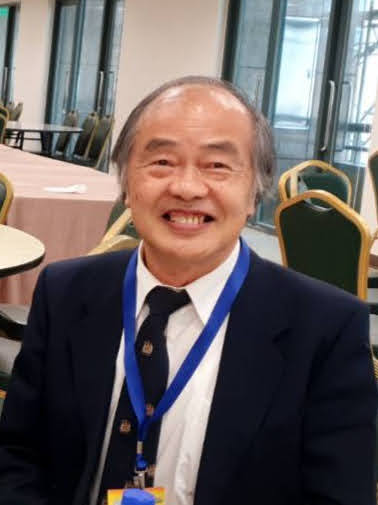
Clinical Cardiology and Cardiovascular Interventions, I would like to express my sincerest gratitude for the trust placed in our team for the publication in your journal. It has been a true pleasure to collaborate with you on this project. I am pleased to inform you that both the peer review process and the attention from the editorial coordination have been excellent. Your team has worked with dedication and professionalism to ensure that your publication meets the highest standards of quality. We are confident that this collaboration will result in mutual success, and we are eager to see the fruits of this shared effort.

Dear Dr. Jessica Magne, Editorial Coordinator 0f Clinical Cardiology and Cardiovascular Interventions, I hope this message finds you well. I want to express my utmost gratitude for your excellent work and for the dedication and speed in the publication process of my article titled "Navigating Innovation: Qualitative Insights on Using Technology for Health Education in Acute Coronary Syndrome Patients." I am very satisfied with the peer review process, the support from the editorial office, and the quality of the journal. I hope we can maintain our scientific relationship in the long term.
Dear Monica Gissare, - Editorial Coordinator of Nutrition and Food Processing. ¨My testimony with you is truly professional, with a positive response regarding the follow-up of the article and its review, you took into account my qualities and the importance of the topic¨.

Dear Dr. Jessica Magne, Editorial Coordinator 0f Clinical Cardiology and Cardiovascular Interventions, The review process for the article “The Handling of Anti-aggregants and Anticoagulants in the Oncologic Heart Patient Submitted to Surgery” was extremely rigorous and detailed. From the initial submission to the final acceptance, the editorial team at the “Journal of Clinical Cardiology and Cardiovascular Interventions” demonstrated a high level of professionalism and dedication. The reviewers provided constructive and detailed feedback, which was essential for improving the quality of our work. Communication was always clear and efficient, ensuring that all our questions were promptly addressed. The quality of the “Journal of Clinical Cardiology and Cardiovascular Interventions” is undeniable. It is a peer-reviewed, open-access publication dedicated exclusively to disseminating high-quality research in the field of clinical cardiology and cardiovascular interventions. The journal's impact factor is currently under evaluation, and it is indexed in reputable databases, which further reinforces its credibility and relevance in the scientific field. I highly recommend this journal to researchers looking for a reputable platform to publish their studies.

Dear Editorial Coordinator of the Journal of Nutrition and Food Processing! "I would like to thank the Journal of Nutrition and Food Processing for including and publishing my article. The peer review process was very quick, movement and precise. The Editorial Board has done an extremely conscientious job with much help, valuable comments and advices. I find the journal very valuable from a professional point of view, thank you very much for allowing me to be part of it and I would like to participate in the future!”

Dealing with The Journal of Neurology and Neurological Surgery was very smooth and comprehensive. The office staff took time to address my needs and the response from editors and the office was prompt and fair. I certainly hope to publish with this journal again.Their professionalism is apparent and more than satisfactory. Susan Weiner

My Testimonial Covering as fellowing: Lin-Show Chin. The peer reviewers process is quick and effective, the supports from editorial office is excellent, the quality of journal is high. I would like to collabroate with Internatioanl journal of Clinical Case Reports and Reviews.
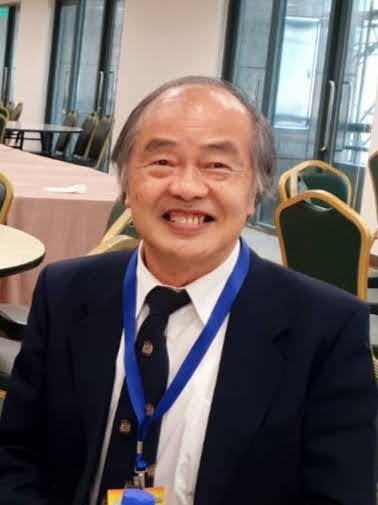
My experience publishing in Psychology and Mental Health Care was exceptional. The peer review process was rigorous and constructive, with reviewers providing valuable insights that helped enhance the quality of our work. The editorial team was highly supportive and responsive, making the submission process smooth and efficient. The journal's commitment to high standards and academic rigor makes it a respected platform for quality research. I am grateful for the opportunity to publish in such a reputable journal.
My experience publishing in International Journal of Clinical Case Reports and Reviews was exceptional. I Come forth to Provide a Testimonial Covering the Peer Review Process and the editorial office for the Professional and Impartial Evaluation of the Manuscript.

I would like to offer my testimony in the support. I have received through the peer review process and support the editorial office where they are to support young authors like me, encourage them to publish their work in your esteemed journals, and globalize and share knowledge globally. I really appreciate your journal, peer review, and editorial office.
Dear Agrippa Hilda- Editorial Coordinator of Journal of Neuroscience and Neurological Surgery, "The peer review process was very quick and of high quality, which can also be seen in the articles in the journal. The collaboration with the editorial office was very good."

I would like to express my sincere gratitude for the support and efficiency provided by the editorial office throughout the publication process of my article, “Delayed Vulvar Metastases from Rectal Carcinoma: A Case Report.” I greatly appreciate the assistance and guidance I received from your team, which made the entire process smooth and efficient. The peer review process was thorough and constructive, contributing to the overall quality of the final article. I am very grateful for the high level of professionalism and commitment shown by the editorial staff, and I look forward to maintaining a long-term collaboration with the International Journal of Clinical Case Reports and Reviews.
To Dear Erin Aust, I would like to express my heartfelt appreciation for the opportunity to have my work published in this esteemed journal. The entire publication process was smooth and well-organized, and I am extremely satisfied with the final result. The Editorial Team demonstrated the utmost professionalism, providing prompt and insightful feedback throughout the review process. Their clear communication and constructive suggestions were invaluable in enhancing my manuscript, and their meticulous attention to detail and dedication to quality are truly commendable. Additionally, the support from the Editorial Office was exceptional. From the initial submission to the final publication, I was guided through every step of the process with great care and professionalism. The team's responsiveness and assistance made the entire experience both easy and stress-free. I am also deeply impressed by the quality and reputation of the journal. It is an honor to have my research featured in such a respected publication, and I am confident that it will make a meaningful contribution to the field.

"I am grateful for the opportunity of contributing to [International Journal of Clinical Case Reports and Reviews] and for the rigorous review process that enhances the quality of research published in your esteemed journal. I sincerely appreciate the time and effort of your team who have dedicatedly helped me in improvising changes and modifying my manuscript. The insightful comments and constructive feedback provided have been invaluable in refining and strengthening my work".

I thank the ‘Journal of Clinical Research and Reports’ for accepting this article for publication. This is a rigorously peer reviewed journal which is on all major global scientific data bases. I note the review process was prompt, thorough and professionally critical. It gave us an insight into a number of important scientific/statistical issues. The review prompted us to review the relevant literature again and look at the limitations of the study. The peer reviewers were open, clear in the instructions and the editorial team was very prompt in their communication. This journal certainly publishes quality research articles. I would recommend the journal for any future publications.
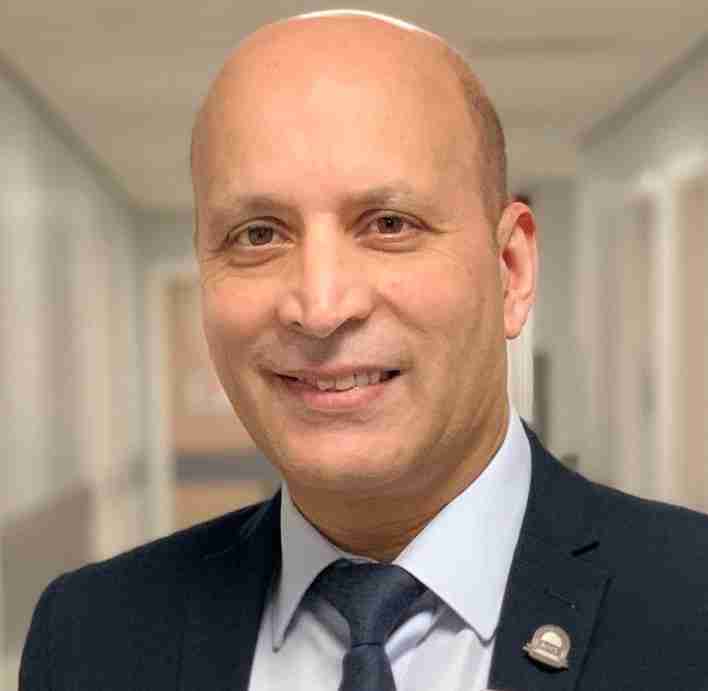
Dear Jessica Magne, with gratitude for the joint work. Fast process of receiving and processing the submitted scientific materials in “Clinical Cardiology and Cardiovascular Interventions”. High level of competence of the editors with clear and correct recommendations and ideas for enriching the article.

We found the peer review process quick and positive in its input. The support from the editorial officer has been very agile, always with the intention of improving the article and taking into account our subsequent corrections.

My article, titled 'No Way Out of the Smartphone Epidemic Without Considering the Insights of Brain Research,' has been republished in the International Journal of Clinical Case Reports and Reviews. The review process was seamless and professional, with the editors being both friendly and supportive. I am deeply grateful for their efforts.
To Dear Erin Aust – Editorial Coordinator of Journal of General Medicine and Clinical Practice! I declare that I am absolutely satisfied with your work carried out with great competence in following the manuscript during the various stages from its receipt, during the revision process to the final acceptance for publication. Thank Prof. Elvira Farina

Dear Jessica, and the super professional team of the ‘Clinical Cardiology and Cardiovascular Interventions’ I am sincerely grateful to the coordinated work of the journal team for the no problem with the submission of my manuscript: “Cardiometabolic Disorders in A Pregnant Woman with Severe Preeclampsia on the Background of Morbid Obesity (Case Report).” The review process by 5 experts was fast, and the comments were professional, which made it more specific and academic, and the process of publication and presentation of the article was excellent. I recommend that my colleagues publish articles in this journal, and I am interested in further scientific cooperation. Sincerely and best wishes, Dr. Oleg Golyanovskiy.

Dear Ashley Rosa, Editorial Coordinator of the journal - Psychology and Mental Health Care. " The process of obtaining publication of my article in the Psychology and Mental Health Journal was positive in all areas. The peer review process resulted in a number of valuable comments, the editorial process was collaborative and timely, and the quality of this journal has been quickly noticed, resulting in alternative journals contacting me to publish with them." Warm regards, Susan Anne Smith, PhD. Australian Breastfeeding Association.
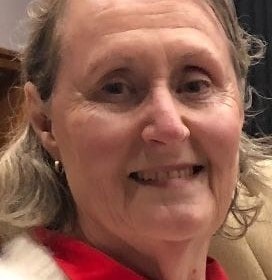
Dear Jessica Magne, Editorial Coordinator, Clinical Cardiology and Cardiovascular Interventions, Auctores Publishing LLC. I appreciate the journal (JCCI) editorial office support, the entire team leads were always ready to help, not only on technical front but also on thorough process. Also, I should thank dear reviewers’ attention to detail and creative approach to teach me and bring new insights by their comments. Surely, more discussions and introduction of other hemodynamic devices would provide better prevention and management of shock states. Your efforts and dedication in presenting educational materials in this journal are commendable. Best wishes from, Farahnaz Fallahian.
Dear Maria Emerson, Editorial Coordinator, International Journal of Clinical Case Reports and Reviews, Auctores Publishing LLC. I am delighted to have published our manuscript, "Acute Colonic Pseudo-Obstruction (ACPO): A rare but serious complication following caesarean section." I want to thank the editorial team, especially Maria Emerson, for their prompt review of the manuscript, quick responses to queries, and overall support. Yours sincerely Dr. Victor Olagundoye.
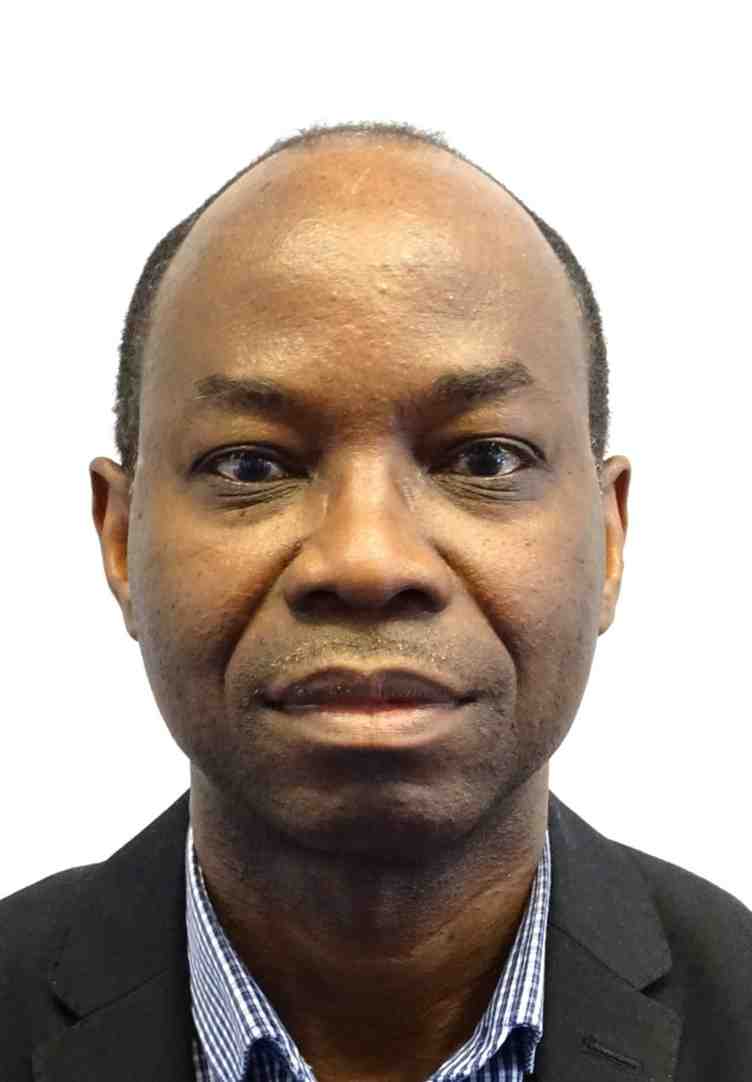
Dear Ashley Rosa, Editorial Coordinator, International Journal of Clinical Case Reports and Reviews. Many thanks for publishing this manuscript after I lost confidence the editors were most helpful, more than other journals Best wishes from, Susan Anne Smith, PhD. Australian Breastfeeding Association.
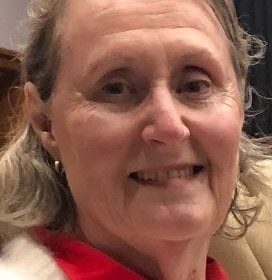
Dear Agrippa Hilda, Editorial Coordinator, Journal of Neuroscience and Neurological Surgery. The entire process including article submission, review, revision, and publication was extremely easy. The journal editor was prompt and helpful, and the reviewers contributed to the quality of the paper. Thank you so much! Eric Nussbaum, MD
Dr Hala Al Shaikh This is to acknowledge that the peer review process for the article ’ A Novel Gnrh1 Gene Mutation in Four Omani Male Siblings, Presentation and Management ’ sent to the International Journal of Clinical Case Reports and Reviews was quick and smooth. The editorial office was prompt with easy communication.

Dear Erin Aust, Editorial Coordinator, Journal of General Medicine and Clinical Practice. We are pleased to share our experience with the “Journal of General Medicine and Clinical Practice”, following the successful publication of our article. The peer review process was thorough and constructive, helping to improve the clarity and quality of the manuscript. We are especially thankful to Ms. Erin Aust, the Editorial Coordinator, for her prompt communication and continuous support throughout the process. Her professionalism ensured a smooth and efficient publication experience. The journal upholds high editorial standards, and we highly recommend it to fellow researchers seeking a credible platform for their work. Best wishes By, Dr. Rakhi Mishra.

Dear Jessica Magne, Editorial Coordinator, Clinical Cardiology and Cardiovascular Interventions, Auctores Publishing LLC. The peer review process of the journal of Clinical Cardiology and Cardiovascular Interventions was excellent and fast, as was the support of the editorial office and the quality of the journal. Kind regards Walter F. Riesen Prof. Dr. Dr. h.c. Walter F. Riesen.

Dear Ashley Rosa, Editorial Coordinator, International Journal of Clinical Case Reports and Reviews, Auctores Publishing LLC. Thank you for publishing our article, Exploring Clozapine's Efficacy in Managing Aggression: A Multiple Single-Case Study in Forensic Psychiatry in the international journal of clinical case reports and reviews. We found the peer review process very professional and efficient. The comments were constructive, and the whole process was efficient. On behalf of the co-authors, I would like to thank you for publishing this article. With regards, Dr. Jelle R. Lettinga.

Dear Clarissa Eric, Editorial Coordinator, Journal of Clinical Case Reports and Studies, I would like to express my deep admiration for the exceptional professionalism demonstrated by your journal. I am thoroughly impressed by the speed of the editorial process, the substantive and insightful reviews, and the meticulous preparation of the manuscript for publication. Additionally, I greatly appreciate the courteous and immediate responses from your editorial office to all my inquiries. Best Regards, Dariusz Ziora

Dear Chrystine Mejia, Editorial Coordinator, Journal of Neurodegeneration and Neurorehabilitation, Auctores Publishing LLC, We would like to thank the editorial team for the smooth and high-quality communication leading up to the publication of our article in the Journal of Neurodegeneration and Neurorehabilitation. The reviewers have extensive knowledge in the field, and their relevant questions helped to add value to our publication. Kind regards, Dr. Ravi Shrivastava.

Dear Clarissa Eric, Editorial Coordinator, Journal of Clinical Case Reports and Studies, Auctores Publishing LLC, USA Office: +1-(302)-520-2644. I would like to express my sincere appreciation for the efficient and professional handling of my case report by the ‘Journal of Clinical Case Reports and Studies’. The peer review process was not only fast but also highly constructive—the reviewers’ comments were clear, relevant, and greatly helped me improve the quality and clarity of my manuscript. I also received excellent support from the editorial office throughout the process. Communication was smooth and timely, and I felt well guided at every stage, from submission to publication. The overall quality and rigor of the journal are truly commendable. I am pleased to have published my work with Journal of Clinical Case Reports and Studies, and I look forward to future opportunities for collaboration. Sincerely, Aline Tollet, UCLouvain.

Dear Ms. Mayra Duenas, Editorial Coordinator, International Journal of Clinical Case Reports and Reviews. “The International Journal of Clinical Case Reports and Reviews represented the “ideal house” to share with the research community a first experience with the use of the Simeox device for speech rehabilitation. High scientific reputation and attractive website communication were first determinants for the selection of this Journal, and the following submission process exceeded expectations: fast but highly professional peer review, great support by the editorial office, elegant graphic layout. Exactly what a dynamic research team - also composed by allied professionals - needs!" From, Chiara Beccaluva, PT - Italy.

Dear Maria Emerson, Editorial Coordinator, we have deeply appreciated the professionalism demonstrated by the International Journal of Clinical Case Reports and Reviews. The reviewers have extensive knowledge of our field and have been very efficient and fast in supporting the process. I am really looking forward to further collaboration. Thanks. Best regards, Dr. Claudio Ligresti